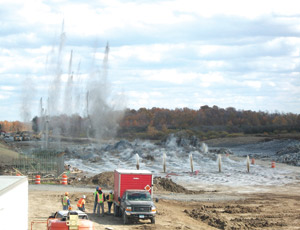WHEN AN ARMY of construction associations closed ranks last year to sue New York state transportation officials over halted payments to contractors, it was fair to expect some bad blood. Instead, the result was an environment of cooperation that brought industry and government into closer partnership than ever before.

The transition from conflict to collaboration was achieved by a department leadership that steered through obstacles to deliver a construction program nearly double its normal size. Such accomplishments earned the New York State Department of Transportation honors as ENR New York’s Owner of the Year.
The state’s budget woes hit a low point last April, when then-Gov. David Paterson responded to an impasse with the state Legislature by crafting continuing funding resolutions that excluded various operations, including payments to roadway contractors.
It’s one thing to pay invoices late; it’s another to halt payments but keep contractual obligations in effect, says Ross Pepe, president of the Construction Industry Council of Westchester and the Hudson Valley. “You had projects in the range of $300 million to $400 million going on at that time with a full schedule of employment and materials placing,” he says. “There were contractors out millions of dollars.”
Work stopped on a handful of jobs, though most contractors stretched lines of credit or struggled for other ways to scrape by, Pepe says. So his organization and peer associations took unprecedented action last April—suing the agency in a case that named then-acting Commissioner Stanley Gee as a defendant.
It so happens that Gee is one of the first people to whom industry players give credit for resolving the crisis. Indeed, some call the agency a solid partner throughout the episode.
“Stanley was willing to communicate,” says Karen Morrison, vice president of transportation and technical services for the AGC’s New York state chapter. “He responded to the industry’s request to come to the table and bring the right people.”
Contractors recognized the agency was stuck in the middle, says Stephen Forrestel, president of Cold Spring Construction in Akron, N.Y. “Given the constraints that the state had thrown at them, [transportation officials] did a great job of helping us and allowing us to work,” he adds.
In the midst of the crisis, Gee’s team started a “somewhat remarkable” weekly call that updated industry members on payments and other budget-related issues, Morrison says. That call still takes place today.
Challenging Landscape
The department of transportation had its share of hurdles last year, notably executing a supersized $3-billion capital program, fueled partly by $1.2 billion in federal stimulus funding through the American Recovery and Investment Act of 2009.
There were structural challenges as well, particularly a spate of early retirements—including 208 staffers from the engineering division—coupled with a hiring freeze that cut more than 240 positions in fiscal 2009. It navigated these shoals with an acting chief; Gee was installed in May 2009 following the departure of Astrid Glynn after two years as commissioner.
Gee had a long career with the Federal Highway Administration before joining NYSDOT in 2007 as executive deputy commissioner, and that experience guided him, Pepe says. “Stan understood the problems that existed,” Pepe adds.
Still, it was a partnership born of conflict, including fears that spurred contractor groups to file suit against the agency. “It wasn’t clear if these [nonpayment] policies were going to last several months, and that’s why we reacted so strongly,” says Denise Richardson, managing director of the General Contractors Association of New York.
Nevertheless, Pepe says the department began taking action early on to soften the blow of the canceled payments, which lasted about a month and affected about 500 projects. A key early move, he says, was a determination by agency officials that they could continue paying contractors with federal dollars on projects using stimulus funds. Another was a decision by department leaders not to automatically pursue breach of contract actions against contractors that had to stop project work due to nonpayment. And the department also played a role in eventually restoring contractor payments in the continuing resolutions.
The agency also built on an existing platform of quarterly meetings with industry associations to launch weekly Friday morning conference calls with senior department officials, cementing a sense of teamwork, Morrison says.
“It was definitely communication from the top,” she adds. “We were able to keep our members informed on the status of payments and awards. No one felt that they were hanging out on a wire.”
Breaking Ground
In the midst of this drama, many projects kept rolling as the agency and contractors started, continued and finished jobs. Among the highest-profile effort was the new $70-million Lake Champlain Bridge linking Crown Point, N.Y., and Chimney Point, Vt., which got under way last year after transportation officials from both states determined in October 2009 that piers on an existing 80-year-old structure had badly deteriorated and immediately closed the bridge down. Within months they had demolished the old bridge, opened a 24-hour ferry service and mapped out a new structure on which they are splitting the cost. The departments selected Flatiron Construction in May 2010, and the new bridge is set to open this October.

Post a comment to this article
Report Abusive Comment